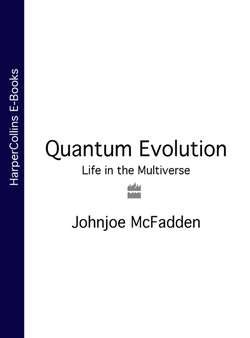Читать книгу Quantum Evolution: Life in the Multiverse - Johnjoe McFadden - Страница 32
THE PROTO-CELL
ОглавлениеMolecular evolutionary studies have established the existence of the major domains, but what kind of creature was the ancestor of the Archaea, eubacteria and eukaryotes: the proto-cell? That there was indeed a single common ancestor of all cellular life is indicated by the number of features we all have in common (DNA, RNA, ribosomes, the genetic code); but what did that proto-cell look like? How did it live?
We can make an estimate of how many genes the proto-cell is likely to have possessed by counting the number of genes found in all three domains of life. The simplest explanation for the presence of common genes is that they reflect a common inheritance from the proto-cell. Scientists who have examined genes from each of the three domains estimate that there are eight hundred to a thousand ancient conserved regions (ACRs) in modern proteins.6
Surprisingly perhaps, eight hundred to a thousand genes is a little more than the number of genes present in the genome of a living bacterium, Mycoplasma genitalium. This organism causes non-gonoccocal urethritis (inflammation of the urethra which is not gonorrhoea) and respiratory infections in humans, and has the smallest known genome of any living creature. Its entire chromosome of 580,070 DNA bases has been sequenced and found to code for only four hundred and seventy proteins. However, this microbe is not really a free-living organism – it lacks the enzymes necessary to make many essential biochemicals. It barely manages to replicate under very cosseted laboratory conditions. It is actually a highly evolved parasite that relies on our cells to do much of its biosynthetic hard work. It is not a feasible proto-cell. Nevertheless we will accept a lower estimate of about five hundred genes as the minimum number of genes likely to have been present in the last common ancestor of all cellular life, the proto-cell.
But what was the proto-cell like? We can approach this question by examining the characteristics of the deepest branches of the rRNA tree. For instance, the deepest branching Archaea are thermophilic bacteria that breathe sulfur compounds. The deepest branches of the eubacterial domain are thermophilic (heat-loving), sulfur-utilizing photosynthetic bacteria; suggesting that the proto-eubacterium was an anaerobic photosynthetic cell. Most researchers do not think it likely that photosynthesis evolved very early in life. It is a highly complex reaction that requires the co-operative action of many enzymes. The more ancestral characteristics are likely to be closer to the Archaea that use the energy of sulfur compounds directly to fix carbon dioxide. On this basis, the likely characteristics of the proto-cell were probably similar to the Archaea, suggesting it lived in a hot, sulfurous, oxygen-free environment and it used sulfur to fix carbon dioxide.
But when did the proto-cell live? Do the conditions we have described correspond to the likely environment where it emerged?
